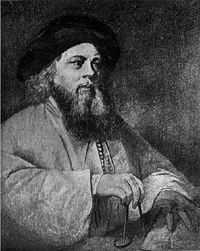- Baal Shem of London
-
Baal Shem of London 
Variations of this portrait, originally subtitled "Baal Shem", are popularly used to represent Israel Baal Shem Tov. Instead it is held to depict rather, Rabbi Falk, the Baal Shem of London[1]Personal details Birth name Hayyim Samuel Jacob Falk Born 1708 Died April 17, 1782 (aged 73–74) Rabbi Dr Hayyim Samuel Jacob Falk (Hebrew: חיים שמואל יעקב פאלק; Also known as the Baal Shem of London and Doctor Falckon; 1708 - 17 April 1782) was a rabbi, Practical Kabbalist and alchemist.
Contents
Early Life
Falk was born in either Fürth in Bavaria or Pidhaytsi in Podolia. In 1742 he arrived in London after narrowly escaping being burnt at the stake by the authorities in Westphalia who charged him with sorcery. He lived at 35 Prescott Street, London, United Kingdom and at Wellclose Square, London until his death.
Repute
Because of his reputation as a Practical Kabbalist who worked miracles and appeared to have magical powers which involved the use of divine names, he was known by the Jews of London as the "Baal Shem of London". He ran a secret occult group out of his home and had an alchemical laboratory in one of the houses on London Bridge.
In London Falk amassed a great wealth. He took up residence at a house in Wellclose Square formerly occupied by Judith Levy, Moses Hart's eccentric daughter. Here he was waited on by nobles, aristocrats, and princes, such as the fair Marquise de la Croix, who had been instrumental in saving many Jews from the clutches of the Inquisition. He did various rituals to assist Theodore of Corsica in his efforts to regain his royal inheritance. In France it was said that Falk had given a magical ring of Lapis lazuli (some accounts suggest a talisman) to Louis Philippe II, Duke of Orléans which would ensure that he would succeed to the throne. He supposedly passed the ring to his son who in 1830 became the king of France as Louis Philippe.
Folklore surrounding Falk
Many stories were current concerning Falk's extraordinary powers. According to one account, it was Falk's custom to make clandestine visits to Epping Forest in his carriage, where he was reported to have buried quantities of treasure. On one of these occasions a wheel came loose from the vehicle on the Whitechapel Road, but followed the carriage all the way to the forest. When Falk ran short of coal, he was said to have performed a magical feat involving three shirts and a ram's horn.[2] Falk was also able to keep candles burning miraculously, and to transport objects from one place to another.
Some claimed that he had saved the Great Synagogue from a fire raging in the neighbourhood by writing four Hebrew letters on the pillars of the door. The most famous tale of Rabbi Falk concerns his connection with the death of Aaron Goldsmid, one of the Baal Shem's executors appointed in his will.[3]
Jewish opinion of Falk
The Baal Shem of London was received very equivocally by the Jews themselves, however, although he seems to have been friendly with Chief Rabbi David Tevele Schiff, whom Falk referred to as the "rabbi of London and the entire country".[4] Falk bequeathed in his will an annual sum of 100 pounds to the Great Synagogue (Duke's Place), London as well as some Sefer Toarahs.
Rabbi Jacob Emden accused him of being a Sabbatean, a supporter of Sabbati Zevi, as he invited Moses David of Podhayce, a known Sabbatean with connections to Jonathan Eibeschutz, to his home.[5]
Diary and Biography
Falk kept a diary containing records of dreams and the Kabbalistic names of angels. This can be found in the library of the United Synagogue in London. In 2002 Michal Oren published the diary and a biography of Falk[6]. The diary is written in Hebrew and is very cryptic. The diary was published together with the diary of Falk's assistant, Tsvee Hirsch of Kalish.
Death and Burial
He died on 17 April 1782 and was buried in the cemetery at Globe Road, Mile End.
References
- ^ http://www.tovste.info/Personalities/BaalShemTov.php
- ^ Isaacs, Hyam (1850). Ceremonies, Customs, Rites, and Traditions of the Jews. William Buck. pp. 355–356.
- ^ Alexander, Levy (1808). Memoirs of the Life of Benjamin Goldsmid.
- ^ Falk's commonplace book: Jewish Museum, London: United Synagogue Beth HaMidrash Library, London, as summarized in Adler, 'Baal Shem', 149, 166-73.
- ^ Grözinger, Karl-Erich; Dan, Joseph (1991). Mysticism, Magic and Kabbalah in Ashkenazi Judaism. Berlin: Walter de Gruyter. ISBN 3-1101-3744-5.
- ^ Oren, Michal (2002). Samuel Falk, The Baal shem of London מ'בעל שד' ל'בעל שם'. Bialik Institute. ISBN 965-342-850-0.
- Picciotto, James. Sketches of Anglo-Jewish History. London: Soncino Press, 1956.
- Katz, David S. (1997). The Jews in the History of England, 1485-1850. Oxford University Press. ISBN 0-1982-0667-4.
- Godwin, Joscelyn (1995). The Theosophical Enlightenment. Albany: State University of New York Press. ISBN 0-7914-2151-1.
- This article incorporates text from the 1901–1906 Jewish Encyclopedia article "Falk, Ḥayyim Samuel Jacob" by Joseph Jacobs and Hermann Adler, a publication now in the public domain.
Categories:- Kabbalists
- German rabbis
- Polish rabbis
- 18th-century rabbis
- 1708 births
- 1782 deaths
- Alchemists
- Mystics
- Alleged witches
- Practical Kabbalah
- Jewish English history
- Orthodox Jews in London
Wikimedia Foundation. 2010.
